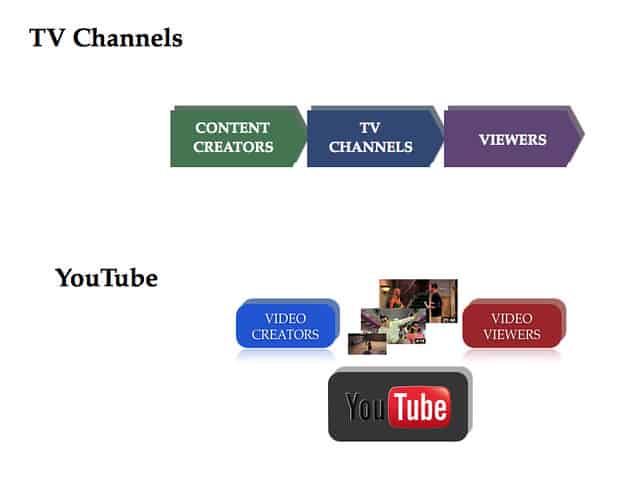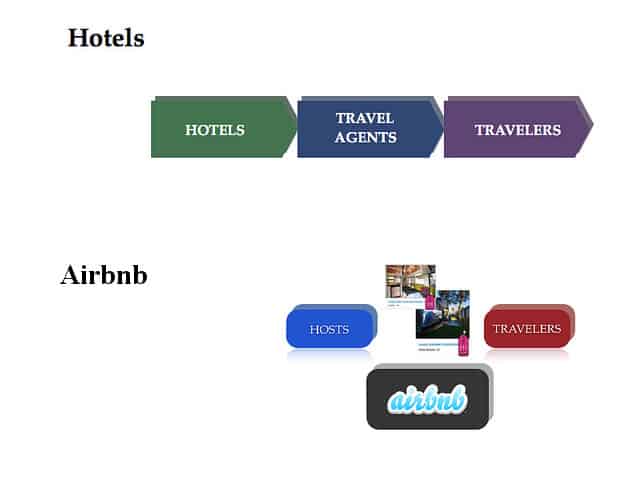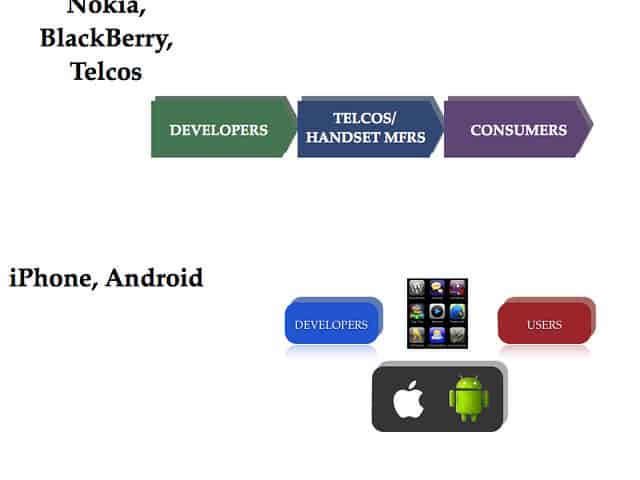Digital Transformation
From Social Media to the Sharing Economy: The Three Drivers of Business Disruption
Shift from Linear to Networked business models
First we went wild about social media disrupting the world of business communications and media. Then the Sharing Economy sprang up, and we talked about how the traditional ownership model was getting disrupted. We’re looking at the 3D printer as the democratization of manufacturing much like Twitter and blogging democratized publishing, and YouTube democratized broadcast.
Disruption isn’t over yet. In fact, it’s just getting started!
But irrespective of which phenomenon you look at ( and even if you dismiss all of these as fads), the enduring shift that underlies all these disruptions is the sudden shift of the respective industries from linear to networked business models – from Pipes to Platforms.
Let’s look at a few examples that illustrate this shift.
From Traditional Media to Social Media
This is what happened to media while it was caught sleeping.
Traditional Media worked like a pipe. There are few better representations of a pipe than TV, radio and newspapers.
YouTube, podcasts, and Huffington Post change this model to a platform model.

What changes?
- The tools of production get democratized, unlocking a new market of producers.
- The source of value creation shifts from employees in-house to a network of partners and users outside.
- As in the case of YouTube, the business may relinquish ownership of the content and allow producers and consumers to interact directly.
From the Ownership Economy to the Sharing Economy
Let’s look at how hotels have worked traditionally. A hotel is in the business of selling accommodation. Hence, to scale, a hotel usually invests in creating more rooms. It owns all the rooms and optimizes its business to maximize occupancy.
Airbnb is in the same business, except that it doesn’t own any rooms. This is how the platform shapes up for Airbnb.

What changes?
- The business relinquishes ownership to the ecosystem.
- A primary goal of the business is creating better mechanisms of trust to identify and differentiate good behavior from poor behavior.
- The value is not in owning resources but in managing the marketplace.
The Rise of the App Economy
We see the same patterns in the rise of the app economy. Handset manufacturers decided which apps to preload. They controlled the process like a pipe. Apple and Google changed the rules of the game in much the same way that Airbnb and YouTube did; by using a networked platform to disrupt a controlled pipe.

From Traditional Manufacturing to 3D printing
While manufacturing has increasingly relied on crowdsourcing platforms, especially for sourcing design, there has never been a concerted shift towards distributed manufacturing because the cost of manufacturing at these individual locations across the world would just be too high (per unit) compared to manufacturing centrally. Manufacturing was, hence, owned inside a factory.
However, with the rise of the 3D printer, there are an increasing number of indicators that manufacturing is going to get much more democratized, leading to the creation of entirely new markets. Industrial designers will sell directly to consumers in every way that graphic designers currently do. Collaboration models in industrial design and assembly will become networked as well, as explained in further detail in the next section.
Platforms create value through ecosystem interactions unlike Pipes that relied on in-house processes
Feel Free to Share
Download
Our Insights Pack!
- Get more insights into how companies apply platform strategies
- Get early access to implementation criteria
- Get the latest on macro trends and practical frameworks
And finally… the Wikipedia of everything
We saw an important shift take hold with Wikipedia. It wasn’t just a new way of organizing the world’s information; it was a new way of organizing a supply chain. For all its apparent inadequacies, Wikipedia was our first glimpse into a future where value creation didn’t need a supply chain, it could be orchestrated on a network of connected users. While creation gets distributed whenever access to creative tools gets democratized, this was the first widespread case of editing getting distributed as well. A linear process could now happen cyclically on a network through edit wars.
I believe the real potential of platforms will come to the fore when we see the Wikipedia of Everything playing itself out. Diverse processes that currently need a controlled supply chain to be coordinated will be run on a platform. We’re already seeing successful early experiments with the likes of Quirky. The rise of 3D printing obviates the need for a controlled distribution chain as well.
I was recently a forum guest at the THNK School of Creative Business, Amsterdam where I discussed these shifts in some detail:
The three shifts characterizing movement from Pipes to Platforms
There are fundamentally three characteristics that differentiate the THEN businesses from the NOW businesses, the Pipes from the Platforms.
Market: Shift from Customers to Producers
The traditional view of the market has been of a customer sitting at the end of the Pipe waiting for products and services to be spewed out. The customer’s relationship with the business was fairly straightforward. The business built what the customer wanted and the customer paid for that.
The customer was king!
That changes with Platforms where the business doesn’t ‘build’ the end value in the first place. The business only enables value creation. The value is ‘built’ by Producers on the Platform.
The Producer is now king! If you cannot get a happy group of producers onto your platform, you may never have any consumers and no revenue.
If you mess around with the Producer, you mess around with the network effect.
Competitive Advantage: Shift from Resources to Ecosystem
The traditional view of competitive advantage has broken down. The traditional view was-“big is beautiful.” The more you own, the better you win. This led to the rise in popularity of vertical integration of business as well as to many mergers and acquisitions. Resources were how you competed.
Increasingly, resources are not the definition of scale anymore. Airbnb and Uber aren’t multi-billion dollar businesses for the employees and resources they control in-house but for the ecosystem they succeed in attracting.
Ecosystems are the new scale and the new source of competitive advantage.
Value Creation: Shift from Processes to Interactions
Media companies rely on a process of sourcing and disseminating media. This is replaced by interactions between users on Twitter and Facebook. The role these two platforms play is largely of matching the right content with the right consumer based on certain parameters.
Lack of resource ownership works in tandem with the movement from processes to ecosystem interactions. On Airbnb, the resources are owned by hosts. On Uber, the resources are owned by cab drivers. But value is created when the right resources can be matched with the right needs.
While hotels and traditional cab companies owning their own fleet would get a team of MBAs working on maximizing capacity utilization, Airbnb and Uber focus on getting data scientists to improve algorithmic matching of supply and demand. Nowhere is the shift from process to interactions better exemplified than in the shift from process re-engineering to data science as the highest paid skill in companies.
Data Scientists are the new MBAs.
Tweetable Takeaways
Data Scientists are the new MBAs. Tweet
The Co-creator, and not the Customer, is king in the age of network effects. Tweet
Ecosystems are the new scale and the new source of competitive advantage. Tweet
Platforms create value through ecosystem interactions unlike Pipes that relied on in-house processes. Tweet
State of the Platform Revolution
The State of the Platform Revolution report covers the key themes in the platform economy in the aftermath of the Covid-19 pandemic.
This annual report, based on Sangeet’s international best-selling book Platform Revolution, highlights the key themes shaping the future of value creation and power structures in the platform economy.
Themes covered in this report have been presented at multiple Fortune 500 board meetings, C-level conclaves, international summits, and policy roundtables.
Subscribe to Our Newsletter













